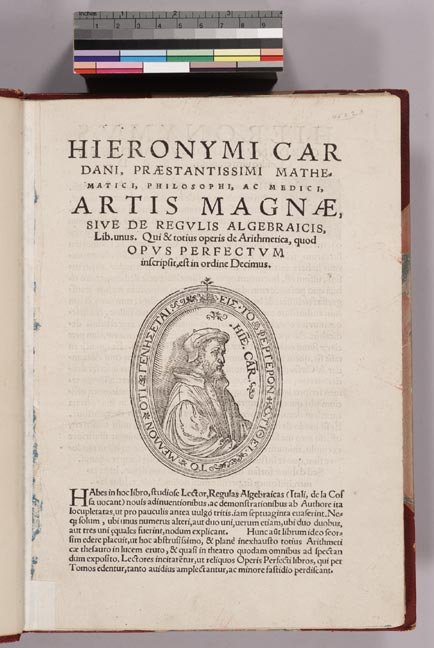- About MAA
- Membership
- MAA Publications
- Periodicals
- Blogs
- MAA Book Series
- MAA Press (an imprint of the AMS)
- MAA Notes
- MAA Reviews
- Mathematical Communication
- Information for Libraries
- Author Resources
- Advertise with MAA
- Meetings
- Competitions
- Programs
- Communities
- MAA Sections
- SIGMAA
- MAA Connect
- Students
- MAA Awards
- Awards Booklets
- Writing Awards
- Teaching Awards
- Service Awards
- Research Awards
- Lecture Awards
- Putnam Competition Individual and Team Winners
- D. E. Shaw Group AMC 8 Awards & Certificates
- Maryam Mirzakhani AMC 10 A Awards & Certificates
- Two Sigma AMC 10 B Awards & Certificates
- Jane Street AMC 12 A Awards & Certificates
- Akamai AMC 12 B Awards & Certificates
- High School Teachers
- News
You are here
Mathematical Treasures - Ars Magna Title Page

This is the title page from the Ars Magna, by Gerolamo Cardano, published in 1545. The page contains an engraving of a portrait of the author. This is the text in which the algebraic solution of cubic equations was first printed. Although the initial discovery of the solution of one type of cubic equation was due to Scipione del Ferro, and solution methods for at least three types were worked out by Niccolò Tartaglia, it was Cardano, along with his student Lodovico Ferrari, who worked out the details for thirteen cases and then published them in this book. The book also contains Ferrari's basic method of solution for quartic equations, as well as much else.
The title page may be translated as follows:
Book one of The Great Art, or the Rules of Algebra, by Gerolamo Cardano, most distinguished mathematician, philosopher, and physician, which is the tenth in order of the whole work on arithmetic, which is titled the perfect work.
You have in this book, diligent reader, the rules of algebra (in Italian, called rules of the coss), so abounding in new discoveries and demonstrations by the author, more than seventy, that earlier works now amount to little (or, in the vernacular, are washed out). It disentangles the knots not only where one term is equal to another or two to one, but also where two are equal to two or three to one. It is a pleasure, therefore, to publish this book separately so that, this most abstruse and unsurpassed treasury of all of arithmetic being brought to light, and as, in a theater exposed to the sight of all, its readers may be encouraged and will all the more readily embrace and with less aversion study thoroughly the remaining books of this perfect work, which will be published volume by volume.
(Translation adapted from that of T. Richard Witmer, The Great Art, Cambridge: MIT Press, 1968.)
Frank J. Swetz and Victor J. Katz, "Mathematical Treasures - Ars Magna Title Page," Convergence (January 2011)




